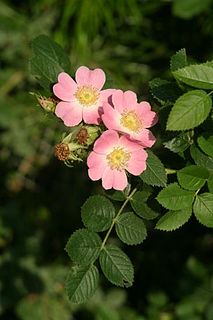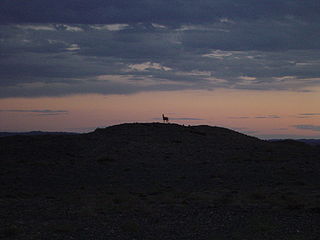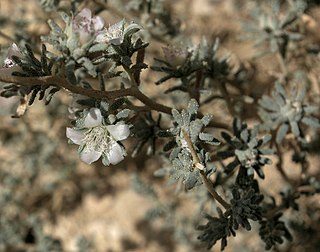
The rose subfamily Rosoideae consists of more than 850 species, including many shrubs, perennial herbs, and fruit plants such as strawberries and brambles. Only a few are annual herbs.

The Eastern Gobi desert steppe is a deserts and xeric shrublands ecoregion in Mongolia and northern China. It is the easternmost of the ecoregions that make up the larger Gobi Desert. It lies between the more humid Mongolian–Manchurian grassland on the north, east, and southeast, and the drier Alashan Plateau semi-desert to the west.

Carl Johann Maximovich was a Russian botanist. Maximovich spent most of his life studying the flora of the countries he had visited in the Far East, and naming many new species. He worked at the Saint Petersburg Botanical Gardens from 1852 as curator of the herbarium collection, becoming Director in 1869.

Rheum is a genus of about 60 herbaceous perennial plants in the family Polygonaceae. Species are native to eastern Europe, southern and eastern temperate Asia, with a few reaching into northern tropical Asia. Rheum is cultivated in Europe and North America. The genus includes the vegetable rhubarb. The species have large somewhat triangular shaped leaves with long, fleshy petioles. The flowers are small, greenish-white to rose-red, and grouped in large compound leafy inflorescences. A number of cultivars of rhubarb have been domesticated both as medicinal plants and for human consumption. While the leaves are slightly toxic, the stalks are used in pies and other foods for their tart flavor.

Leonurus is a genus of flowering plants in the family Lamiaceae. It is native to Europe and Asia, naturalized in New Zealand, Hawaii, New Caledonia, and much of North and South America.

Caryopteris is a genus of flowering plants in the family Lamiaceae. They are native to east Asia.

Kobresia is a genus of plants in the sedge family. They are sometimes called bog sedges. These perennial sedges are quite similar to Carex species in appearance. The genus is widespread across much of Europe, Asia and North America, with many species native to the Himalayas.

Ligularia przewalskii (Maxim.) Diels, also called Przewalski's leopardplant and Przewalski's golden ray, is a species of 1.5–2 m (4.9–6.6 ft) tall perennial herbaceous plant in the genus Ligularia and the family Asteraceae, native to damp places in Mongolia and Northern China and named after Nikolai Przhevalsky. It used to be called Senecio przewalskii Maxim. Przewalski's Ligularia is a popular ornamental plant grown for its large, deeply cut foliage and its tall spike-like inflorescences with bright yellow composite flowers blooming from July to August.

Acer pictum subsp. mono, commonly known as painted maple or mono maple in English, itayakaede (板屋楓) or ezoitaya (蝦夷板屋) in Japan, 五角枫 in China, or gorosoe (고로쇠) or gorosoenamu (고로쇠나무) in Korea, is a species of maple.

Allium lineare is a Eurasian species of wild onions with a wide range extending from France to Mongolia.

Hypericum przewalskii, commonly called Przewalski's St. John's wort, is a flowering plant in Hypericumsect. Roscyna that is native to China.

Reaumuria is a genus of flowering plants in the family Tamaricaceae, found in North Africa, Sicily, Anatolia, the Middle East, the Caucasus, Pakistan, Central Asia, Mongolia, Tibet, and northern China. They tend to be perennial xerophytic and halophytic shrubs or subshrubs.

Cymbaria is a genus of flowering plants in the broomrape family Orobanchaceae, native to Ukraine, Russia, Kazakhstan, Siberia, the Altai, Mongolia, northern China and Manchuria. They are hemiparasites of other plants, obtaining nutrients through haustoria which attach to the roots of the hosts, and doing some photosynthesis on their own.

Lactuca sibirica, Siberian lettuce, is a species of wild lettuce native to Norway, Sweden, Finland, the Baltic states, Belarus, Ukraine, all parts of Russia, Kazakhstan, Mongolia, the northern half of China, the Korean peninsula, Sakhalin, the Kuril Islands, and Japan. It is the host of the systemic rust fungi Puccinia minussensis, which propagates with it along its ramets, resulting in complex host-parasite interactions.

Eriocapitella tomentosa, a species of flowering plant in the buttercup family Ranunculaceae, is native to Asia. The specific epithet tomentosa means "thickly matted with hairs, tomentum (padding)". In Chinese, a common name is da huo cao, which means "fire grass" or "fireweed".
Bothriospermum is a genus of flowering plants belonging to the family Boraginaceae.
Deinostema is a genus of flowering plants belonging to the family Plantaginaceae.
Monochasma is a genus of flowering plants belonging to the family Orobanchaceae.
Przewalskia is a genus of flowering plants belonging to the family Solanaceae.














